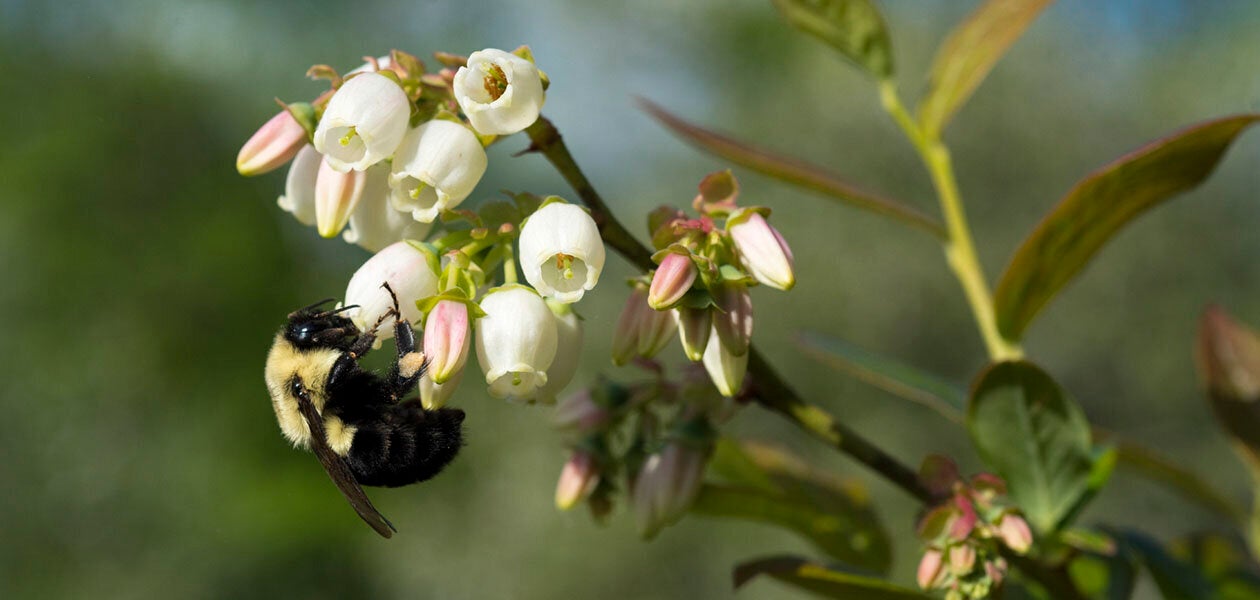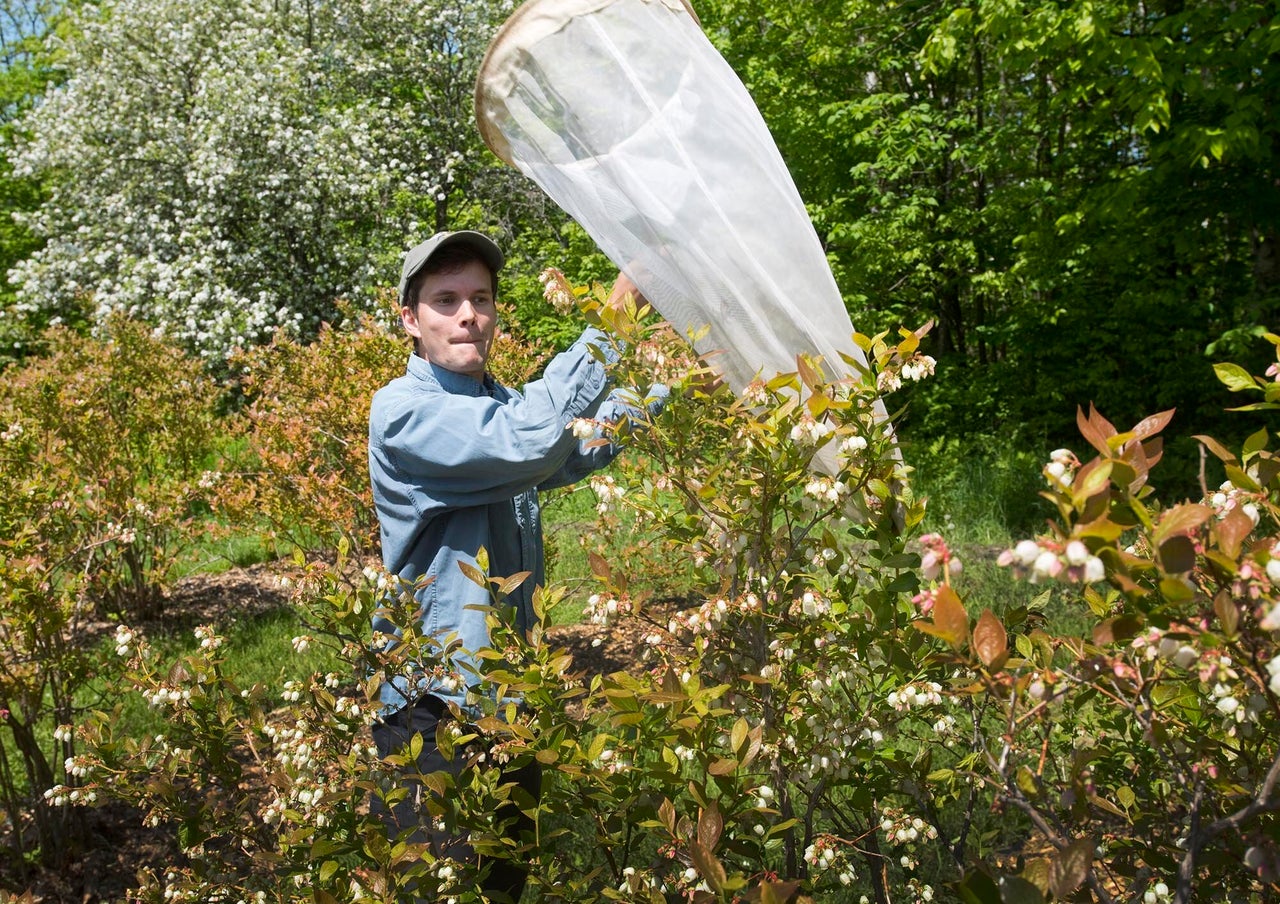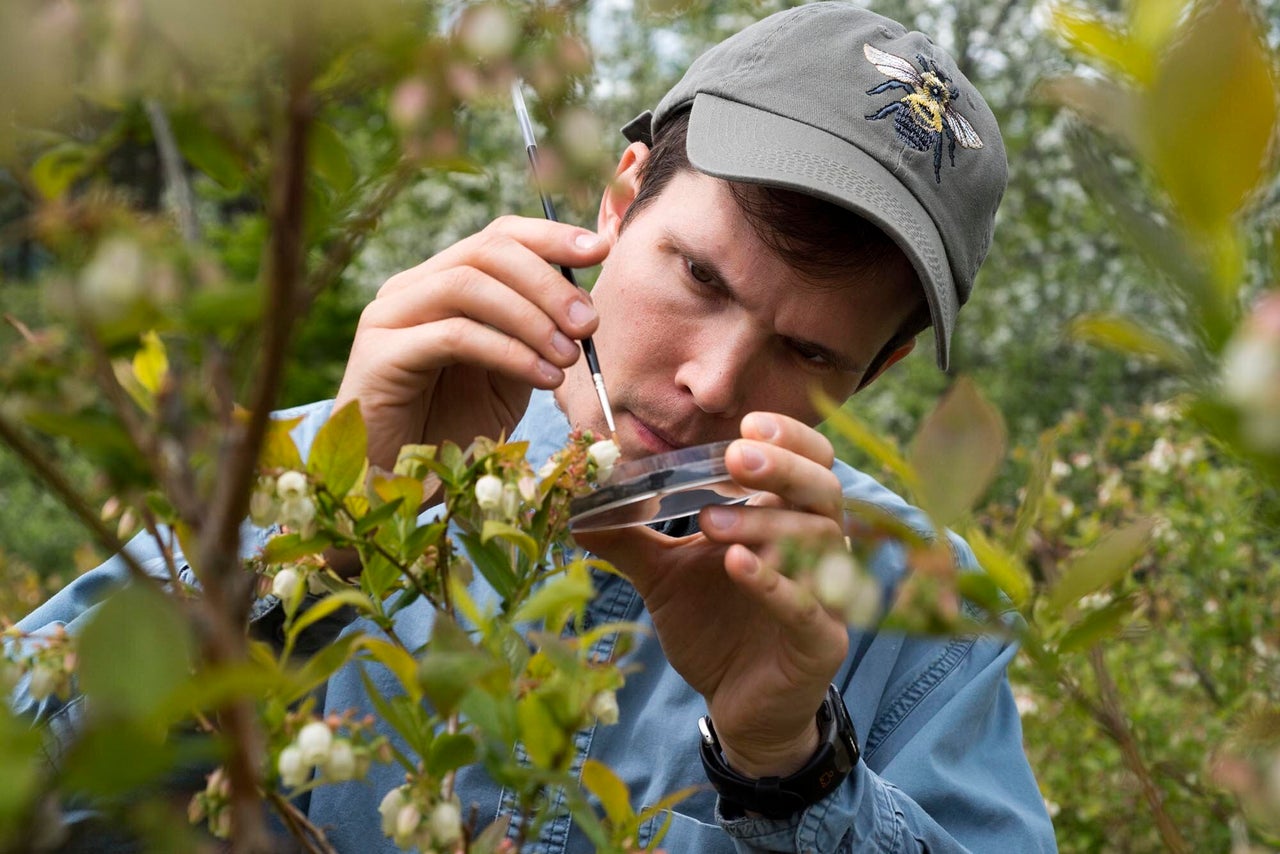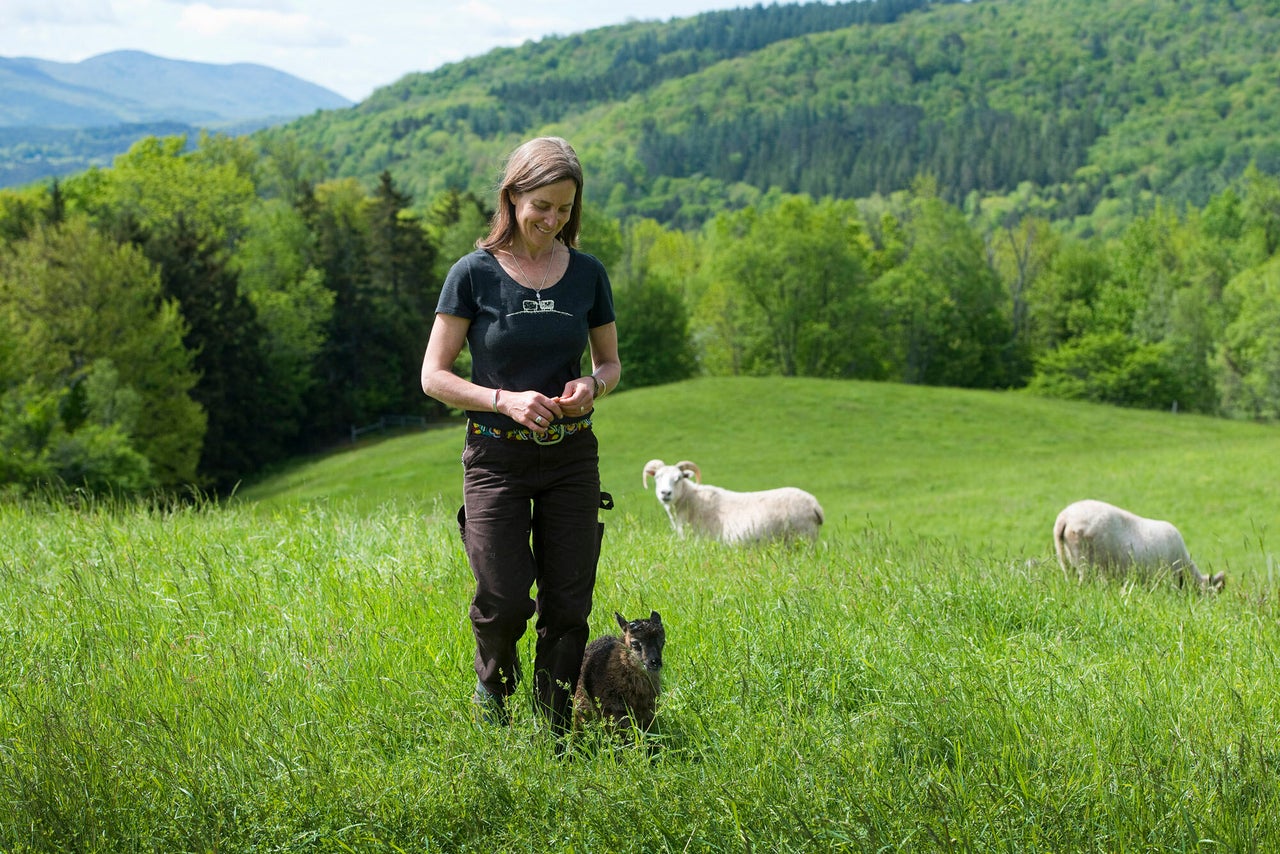On a crisp June morning at Knoll Farm, high above Vermont’s Mad River Valley, Charlie Nicholson stalked a bumblebee. He tiptoed behind the bee as it buzzed along a row of blueberry bushes, carrying a net that resembled a lacrosse stick.
“The trick is to catch the bee without smashing the bush,” he said. “When I first started, I smashed a lot of bushes.”

Nicholson glanced apologetically at Helen Whybrow, Knoll Farm’s owner. “It’s OK,” she said, laughing. “They’re pretty tough.”
For the past three years, Nicholson has been catching, counting and cataloging pollinators on blueberry farms across Vermont as part of his doctoral thesis at the University of Vermont on the value of pollination services. His adviser, Taylor Ricketts, who is the director of the Gund Institute for Environment and one of the world’s foremost experts on the subject, wielded his own net nearby.

“It’s just a flick of the wrist,” said Nicholson, catching the bee from the side and twirling the net around the stick with a little flourish. The bee buzzed in high-pitched annoyance as Nicholson took a look.
“Bombus terricola,” he said, pointing to the yellow band on her abdomen for which this species of bumblebee is named. “That’s one of our threatened bees.” He made a note and released the bee, who went on her way, still grumbling.
As the sun climbed and the temperature rose, clouds of tiny bees joined the scene, but no honeybees. Honeybees are famous for their pollinating prowess, and their colourful hives are standard sights during the blooming season on many farms. But lately, researchers have begun to wonder if wild pollinators — including dozens of species of bumblebees, mining bees and mason bees — have been doing more of the job than they realised. Nicholson and Ricketts chose Vermont for their study because it has so few honeybees.
“Here, the veil of honeybees is lifted,” Ricketts said, “so we can ask: If you have more native bees, do you get more blueberries? And we’ve found the answer is yes.”
The Vermont team recorded the numbers and identities of bees on 15 blueberry farms across the state, as well as the yield. More visits from wild bees led to bigger, better and more bountiful berries.
“If you have more native bees, do you get more blueberries? And we’ve found the answer is yes.”
- Taylor Ricketts, director of the Gund Institute for Environment
They also compared the amount of undeveloped land around each farm to the number of pollinator visits. The farms surrounded by the least natural habitat averaged just a handful of pollinating visitors per square meter over a 10-minute period, while farms in more natural zones averaged 20 to 30 visits.
Knoll Farm wrecked the curve, with more than 50 wild bee visits per square meter every 10 minutes. While it is blessed with lots of surrounding natural habitat, it has no more than farms that received only half as many visits.
Whybrow, who planted her acre of berries in 2001, told me it was so productive that at times it could be a burden. “You can’t pick them fast enough,” she said. “Sometimes it feels like a bush is blue, and you pick it, and you go back later in the day and it’s completely full again!”
As the sun lit the dancing bees like fairies, I joked that maybe they were drawn by the beauty. There’s something about high meadows, a red barn and an old farmhouse that stirs the soul. But this was no conventional farm. Instead of clean, orderly rows, it almost looked like a Japanese garden. Rocky outcroppings. Wildflowers. Shaggy paths curling toward the apple orchard. Random patches of cherries, currants and gooseberries. Even a bouncing brook falling through the centre of it all, creating mini-wetlands too damp to farm.
“We’re messy farmers,” Whybrow said with a laugh. “We let the weeds flourish.”
It’s messy, but it may be the future of farming. As scientists like Ricketts and Nicholson are discovering how incredibly valuable wild pollinators are to our food supply, we are also seeing early signs of a worldwide collapse in pollinator numbers, and industrial agriculture — including commercial beekeeping — is largely to blame. There’s a desperate need for alternative models that work with wild bees, which is what brought me to Knoll Farm on that bright June morning.

Of the 20,000 native bee species, humans chose honeybees to domesticate. Most bees are solitary, but honeybees form vast hives of tens of thousands and live happily in little boxes. Those two qualities have made them the darlings of agriculture, able to deliver serious pollination power wherever it’s needed.
Pollination occurs when the pollen from one flower, which contains the plant’s sperm, is transferred to the flower of another individual of the same species. Only after fertilisation will the plant grow fruit and seed. Although a few food plants, such as grains, are wind-pollinated, most require an animal to do it. Bees, with their furry bodies and floral enthusiasm, do the majority.
For most of history, farms were small, nature was near, and no one had to think much about pollination. But as farms became enormous and natural areas receded, many farmers began importing beehives during the blooming period. Eventually, they stopped thinking of nature as a source of fertility. Most of America’s 2.7 million beehives spend their lives on tractor-trailers, following the bloom from almonds in California to apples in Washington State to blueberries in Maine.
In recent years, public appreciation of the pollination value of honeybees has increased substantially, but much less attention has been paid to wild bees. When you’ve got 20,000 honeybees nuzzling your apple tree, you know it. You barely notice the handful of bumblebees searching for a free flower, much less the tiny mason bees and mining bees and sweat bees. Even many experts assumed their contributions were minor.
“Many plants that are native to the Americas require “buzz pollination” at the right frequency to release pollen. It’s like a secret code known only by their favored partners. Native bees know it. Honeybees don’t.”
That has begun to change. One of the most important studies, for which Ricketts was a co-author, looked at 41 farms on six continents that grew almonds, blueberries, buckwheat, cherries, coffee, cotton, kiwi, mango, passionfruit, pumpkins, strawberries and watermelon. The results blew up the conventional wisdom. Wild insects increased fruiting in every single farm where they were present, but honeybees only produced a significant increase in fruiting 14% of the time. There wasn’t a single crop for which increased fruiting caused by honeybees outperformed that of wild bees. On average, wild bees delivered twice the bump of honeybees.
Nicholson pointed out one of the reasons for that as we watched a big, black bumblebee — Bombus impatiens — land on a blueberry flower, grab hold of the spiky anthers and vibrate her whole body like a fuzzy tuning fork. Her sound rose in frequency to a middle C (think “hey” in “Hey, Jude”) and pollen came flying out of tiny holes in the anthers.
Many plants that are native to the Americas require “buzz pollination” at the right frequency to release pollen. It’s like a secret code known only by their favoured partners. Native bees, which evolved with these plants, know it. Honeybees, which originated in Africa, don’t.
In addition to buzz pollination, native bees have body designs that are better at delivering pollen to flowers’ stigmas, and they tend to graze from plant to plant, which is better for cross-pollination than honeybees’ habit of visiting a single plant and bringing nectar straight back to the hive to make honey.

This realisation has been slow to catch on. “There’s been this understanding among a lot of blueberry farmers that if you want good pollination you have to have honeybee hives,” said Whybrow, who kept hives the first three years she farmed here. “But you can definitely get great pollination without them.”
“The highest-performing farms have almost no honeybees,” said Rickets.
It’s not just blueberries; native bees can do about 10 times the work on squash and pumpkins, too. Increasingly, scientists are recognising that wild bees provide higher-quality pollination. Another paper on which Ricketts was co-author examined 90 studies of 1,394 crop fields around the world and found that honeybees increase food production by an average of $2,913 per hectare, while wild bees boost production by $3,251 per hectare.
Yet most farms around the world suffer from a “pollination deficit” — the gap between how much food they could produce, with perfect pollination, and how much they actually produce. One study of small farms in Africa, Asia and Latin America found that the best way for them to close their “yield gap” was to enhance their pollinator habitat.
As we enter an era of dire food insecurity, one of the easiest things we can do to ensure the global food supply is to enhance populations of wild pollinators. Unfortunately, we seem to be doing just the opposite.
“As wild habitats continue to diminish, and farmers are no longer able to count on bees winging in from nearby forests and fields, they may need to start thinking differently about the fertility of their own land.”
In the past few years, numerous studies have found staggering drops in insect abundance. Another of Ricketts’ grad students, Insu Koh, found that wild bee abundance in the U.S. plunged 23% in just five years. Many of the places native bees are declining the fastest, such as the Midwest and California’s Central Valley, are where we’re planting the most bee-needy crops — things like apples, blueberries, peaches, pumpkins and melons — setting up a disastrous mismatch between pollination supply and demand.
Habitat loss is the top cause of these declines, though pesticides, climate change, invasive species and introduced pathogens all contribute. Ironically, honeybees are also part of the problem. Diseases spread quickly between honeybee operations, which are basically the urban slums of the bee world, and are then transported around the country by migratory beekeepers. Those diseases can then be passed to wild bees through shared flowers. A new study by Alison Brody, another pollination researcher at the University of Vermont, found that bumblebees near honeybee apiaries were more likely to have viruses and that the flowers near apiaries were crawling with bee viruses.
Commercial farms, which are where most honeybee hives are found, are an even bigger problem. Ironically, they are also often the operations that have been unwittingly depending on the services of wild bees. But as wild habitats continue to diminish, and farmers are no longer able to count on bees winging in from nearby forests and fields, they may need to start thinking differently about the fertility of their own land — which may have to start looking a lot more like Knoll Farm.

Ricketts thinks the reason Knoll is such a “superstar farm” has to do with the diversity of the land. “She’s got a little bit of everything here,” he said. “So many flowers and nesting sites.”
Whybrow said she tries to be mindful of what’s happening in the different pockets of land and protect them. “We’ve got these semi-wild spots all over the farm that interconnect. I think that’s where the insects are flourishing.” That explained the Japanese-garden vibe, the sweep of wildflowers that unfurled from spring to fall and the little brook that cascaded toward the valley, offering innumerable spots for a thirsty bee to get a drink. Whybrow wasn’t just farming berries. She was farming pollinators.
And that’s a model that can definitely be replicated. In his blueberry study, Nicholson found that organic farms received nearly twice the pollinator visits of conventional farms. What I hadn’t realised until visiting Knoll, however, was that a lot of those visitors weren’t actually visitors at all. They were locals.
Practices like organic farming, wildflower planting and maintaining grassy margin strips can triple the abundance of major crop-pollinating bees on a farm. And nearly 80% of wild pollination comes from a handful of species that thrive in farm environments.
Supporting healthy, diverse farmscapes is about as easy a way to address food insecurity as you’ll find, said Ricketts. “At our institute, we work on a lot of crazy, global, intractable problems, like climate change. This is not one of those. The solution is pretty clear and pretty doable.”
On that clear Vermont morning, it certainly felt that way. The day had warmed, and a dozen species of wild bees had joined the party. Who wouldn’t want to be a part of this? For a while, everyone lowered their nets and none of us spoke. We just stood there, listening to the world hum.
This story was produced in collaboration with the Food & Environment Reporting Network, a nonprofit investigative news organisation.
Rowan Jacobsen’s previous writing about bees includes the James Beard Award-winning article “To Bee or Not to Bee” and the book “Fruitless Fall.”
